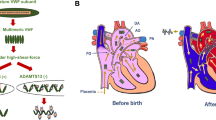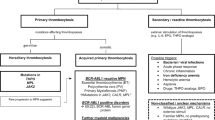Abstract
Antiphospholipid syndrome (APS) is characterized by vascular thrombosis and/or obstetric complications associated with presence of antiphospholipid antibodies (aPL) but additional factors would also induce thrombosis. ABO (H) blood groups are known to be closely related to thrombosis, especially non-O blood type with venous events. The aim of this study was to investigate possible role of ABO (H) blood types in the thrombotic events in primary APS (PAPS). Seventy PAPS patients were selected for the study and were divided according to ABO blood group in: O PAPS (n = 26) and non-O PAPS (n = 44). ABO blood group phenotyping was performed by indirect technique. aPL anticardiolipin (aCL) and anti-βeta2 glycoprotein-1 (aβ2GPI) and the concentrations and activities of von Willebrand factor (VWF) were measured with ELISA. Lupus anticoagulant (LA) was detected by coagulation assays. A significant higher frequency of venous events was observed in non-O PAPS group (72.7 vs. 46.2 %, p = 0.040). In contrast, the frequency of arterial events was significantly higher in the O PAPS compared to the non-O PAPS group (69.2 vs. 36.4 %, respectively; p = 0.013). Frequencies of aCL, LA, aβ2GPI and triple aPL positivity were similar in both groups (p > 0.05). VWF antigen (75.54 ± 8.68 vs. 79.51 ± 7.07 IU/dl, p = 0.041) and activity (70.23 ± 11.96 vs. 77.92 ± 13.67 %, p = 0.020) were decreased in O PAPS compared to non-O blood group. VWF:CB/VWF:Ag ratio was similar among groups (p > 0.05). This is the first report that confirms the role of ABO blood system in thrombosis of PAPS and suggests that non-O blood group was related with venous events and O blood group with arterial thrombosis.
Similar content being viewed by others
References
Wilson WA, Gharavi AE, Koike T et al (1999) International consensus statement on preliminary classification criteria for definite antiphospholipid syndrome: report of an international workshop. Arthritis Rheum 42:1309–1311
Miyakis S, Lockshin MD, Atsumi T et al (2006) International consensus statement on an update of the classification criteria for definite antiphospholipid syndrome (APS). J Thromb Haemost 4:295–306
Ruffatti A, Del Ross T, Ciprian M et al (2009) Risk factors for a first thrombotic event in antiphospholipid antibody carriers. A multicentre, retrospective follow-up study. Ann Rheum Dis 68:397–399
Meroni PL, Borghi MO, Raschi E, Tedesco F (2011) Pathogenesis of antiphospholipid syndrome: understanding the antibodies. Nat Rev Rheumatol 7:330–339
Shoenfeld Y, Meroni PL, Toubi E (2009) Antiphospholipid syndrome and systemic lupus erythematosus: are they separate entities or just clinical presentations on the same scale? Curr Opin Rheumatol 21:495–500
Tregouet DA, Heath S, Saut N et al (2009) Common susceptibility alleles are unlikely to contribute as strongly as the FV and ABO loci to VTE risk: results from a GWAS approach. Blood 113:5298–5303
Sode BF, Allin KH, Dahl M, Gyntelberg F, Nordestgaard BG (2013) Risk of venous thromboembolism and myocardial infarction associated with factor V Leiden and prothrombin mutations and blood type. Can Med Assoc J 185:E229–E237
Wu O, Bayoumi N, Vickers MA, Clark P (2008) ABO (H) blood groups and vascular disease: a systematic review and meta-analysis. J Thromb Haemost 6:62–69
Gándara E, Kovacs MJ, Kahn SR et al (2013) Non-OO blood type influences the risk of recurrent venous thromboembolism. A cohort study. Thromb Haemost 110:1172–1179
Rios DRA, Fernandes AP, Figueiredo RC et al (2012) Relationship between ABO blood groups and von Willebrand factor, ADAMTS13 and factor VIII in patients undergoing hemodialysis. J Thromb Thrombolysis 33:416–421
Gallinaro L, Cattini MG, Sztukowska M et al (2008) A shorter von Willebrand factor survival in O blood group subjects explains how ABO determinants influence plasma von Willebrand factor. Blood 111:3540–3545
Bowen DJ (2003) An influence of ABO blood group on the rate of proteolysis of von Willebrand factor by ADAMTS13. J Thromb Haemost 1:33–40
Nossent AY, Van Marion V, Van Tilburg NH et al (2006) von Willebrand factor and its propeptide: the influence of secretion and clearance on protein levels and the risk of venous thrombosis. J Thromb Haemost 4:2556–2562
Lopes AA, Peranovich TM, Maeda NY, Bydlowski SP (2001) Differential effects of enzymatic treatments on the storage and secretion of von Willebrand factor by human endothelial cells. Thromb Res 101:291–297
Lopes AA, Maeda NY, Bydlowski SP (1998) Abnormalities in circulating von Willebrand factor and survival in pulmonary hypertension. Am J Med 105:21–26
Ohira T, Cushman M, Tsai MY et al (2007) ABO blood group, other risk factors and incidence of venous thromboembolism: the longitudinal investigation of thromboembolism etiology (LITE). J Thromb Haemost 5:1455–1461
Pengo V, Tripodi A, Reber G et al (2009) Update of the guidelines for lupus anticoagulant detection. J Thromb Haemost 7:1737–1740
Pengo V, Ruffatti A, Legnani C et al (2010) Clinical course of high-risk patients diagnosed with antiphospholipid syndrome. J Thromb Haemost 8:237–242
Siedel J, Hagele EO, Ziegenhorn J, Wahlefeld AW et al (1983) Reagent for the enzymatic determination of serum total cholesterol with improved lipolytic efficiency. Clin Chem 29:1075–1080
Fossati P, Prencipe L (1982) Serum triglycerides determined colorimetrically with an enzyme that produces hydrogen-peroxide. Clin Chem 28:2077–2080
Warnick GR, Cheung MC, Albers JJ (1979) Comparison of current methods for high-density lipoprotein cholesterol quantitation. Clin Chem 25:596–604
Friedewald WT, Fredrickson DS, Levy RI (1972) Estimation of concentration of low-density lipoprotein cholesterol in plasma, without use of preparative ultracentrifuge. Clin Chem 18:499–502
Spiel AO, Gilbert JC, Jilma B (2008) Von Willebrand factor in cardiovascular disease focus on acute coronary syndromes. Circulation 117:1449–1459
Castaman G (2013) Changes of von Willebrand factor during pregnancy in women with and without von Willebrand disease. Mediterr J Hematol Infect Dis 5:e2013052
Pieters M, de Lange Z, Hoekstra T, Ellis SM, Kruger A (2010) Triglyceride concentration and waist circumference influence alcohol-related plasminogen activator inhibitor-1 activity increase in black South Africans. Blood Coagul Fibrinolysis 21:736–743
Dentali F, Sironi AP, Ageno W et al (2012) Non-O blood type is the commonest genetic risk factor for VTE: results from a meta-analysis of the literature. Semin Thromb Hemost 38:535–547
Dentali F, Sironi AP, Ageno W, Crestani S, Franchini M (2014) ABO blood group and vascular disease: an update. Semin Thromb Hemost 40:49–59
Franchini M, Favaloro EJ, Targher G, Lippi G (2012) ABO blood group, hypercoagulability, and cardiovascular and cancer risk. Crit Rev Clin Lab Sci 49:137–149
Pengo V, Biasiolo A, Pegoraro C, Cucchini U, Noventa F, Iliceto S (2005) Antibody profiles for the diagnosis of antiphospholipid syndrome. Thromb Haemost 93:1147–1152
Sanders YV, Eikenboom J, De Wee EM et al (2013) Reduced prevalence of arterial thrombosis in von Willebrand disease. J Thromb Haemost 11:845–854
Acknowledgments
This study was supported by the Conselho Nacional de Desenvolvimento Científico e Tecnológico, CNPq Grants 479161-2012-7 (SPB), 301411/2009-3 (EB), and 306963/2011-6 (EFB), the Fundação de Amparo a Pesquisa do Estado de São Paulo FAPESP, Grant 2013/02785-5 (RPSS), the Federico Foundation (EB and EFB), and the Instituto Nacional de Ciência e Tecnologia de Fluídos Complexos (SPB).
Conflicts of interest
The authors declare that they have no conflict of interest.
Author information
Authors and Affiliations
Corresponding author
Rights and permissions
About this article
Cite this article
Nascimento, N.M., Bydlowski, S.P., Soares, R.P.S. et al. ABO blood group in primary antiphospholipid syndrome: influence in the site of thrombosis?. J Thromb Thrombolysis 40, 374–378 (2015). https://doi.org/10.1007/s11239-015-1176-8
Published:
Issue Date:
DOI: https://doi.org/10.1007/s11239-015-1176-8




